Electric Locomotive Classes – AC Electrics
On this pageInformation on DC, dual-current and other dual-traction locomotives can be found on this page.
Mixed Use Locomotives
Introduced between 1959 and 1960, these were the first AC electrics on IR. Made by the 50 Cycles European Group, 100 of these were delivered. They were mostly deployed by ER in the Howrah-Asansol-Dhanbad-Mughalsarai section. They were less frequently found 'upstream' in the Delhi-Kanpur-Mughalsarai section, and in the Igatpuri-Bhusaval section of the Central Railway. Mostly used for non-express passenger trains, but some were used double-headed for freight service. Some were still in operation on ER (Sealdah-Lalgola passenger, etc.) even in the late 1990s. All of them have been withdrawn from service. One is preserved at the NRM (#20202, 'Jagjivan Ram').
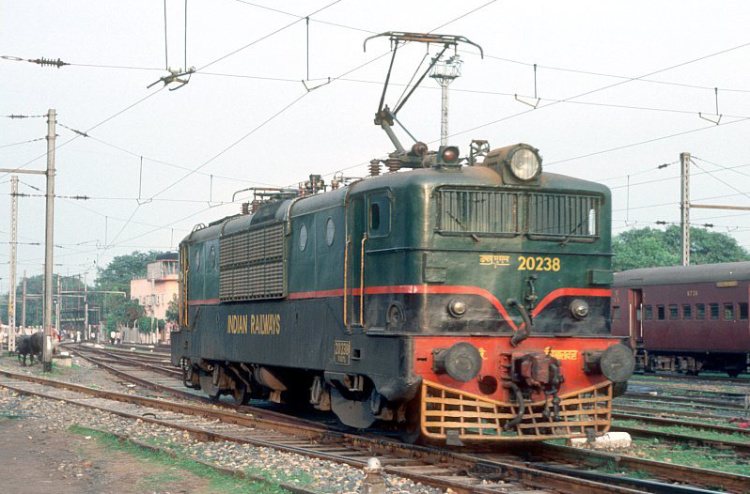
2830hp. B-B (monomotor bogies). Ignitron rectifiers feeding four DC traction motors accepting pulsating current input. Motors are connected to the axles by a Jacquemin drive. Speed control by tap-changer on input transformer (motors permanently wired in parallel). Superstructure mounted on bogies with pendular suspension with equalizer beams. Electricals from ACEC, AEG, Alstom, Brown Boveri, Siemens and others. Jeumont transformer (20 taps), Oerlikon exhauster, Arno rotary converter. Air loco brakes, vacuum train brakes.
| Builders | 50 Cycles European Group (Kraus-Maffei, Krupp, SFAC, La Brugeoise & Nivelle) |
| Traction Motors | Siemens/ACEC/Alstom MG 710A (740hp, 1250V, 480A, 1000 rpm, weight 2750kg). Fully suspended, force-ventilated. |
| Gear Ratio | 16:65 |
| Transformer | Jeumont BOT 3000 |
| Rectifiers | Four water-cooled ignitrons from SGT, each rated for 575kW/1250V |
| Pantographs | Two Faiveley AM-12 |
| Horsepower | 2830hp continuous |
| Axle Load | 18.64t |
| Bogies | B-B (Monomotor) |
| Weight | 74t |
| Starting TE | 25 tons at 33.3% adhesion |
| Continuous TE | 14.8 tons |
| Max. Speed | 112km/h |
| Length Over Buffers | 15892mm |
2870hp Mitsubishi locos delivered between 1961 and 1964. First batch of 10 locos had air brakes for the loco and vacuum train brakes, and the second batch of 26 had only vacuum brakes. These were used on ER, and sometimes ran all the way to New Delhi via Kanpur. They were also used double-headed for freight trains. Four traction motors permanently coupled in parallel are fed by ignitron rectifiers. Speed control is by a tap changer on the input transformer. Mitsubishi transformer, 20 taps. Oerlikon exhauster and compressor, Arno rotary converter. None of this class has been preserved.
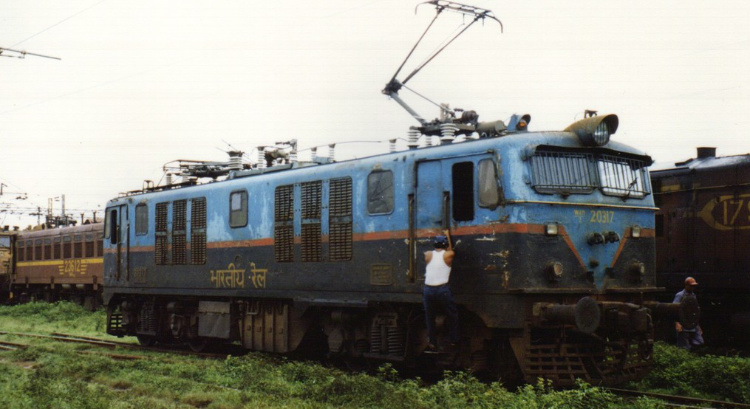
| Builders | Mitsubishi |
| Traction Motors | Mitsubishi MB 3045-A (745hp, 725V, 815A, 1000 rpm, weight 2200kg) |
| Gear Ratio | 17:66 |
| Transformer | Mitsubishi, 3000kVA |
| Rectifiers | 8 Mitsubishi water-cooled ignitrons (GU 31), rated at 725V/390A |
| Pantographs | Two Faiveley AM-12 |
| Horsepower | 2870hp |
| Axle Load | 19.1t |
| Bogies | Bo-Bo |
| Weight | 76.03t |
| Starting TE | 25.2 tons at 33.2% adhesion |
| Continuous TE | 14.5 tons |
| Max. Speed | 112km/h |
| Length Over Buffers | 15000mm |
Only two of these locos existed (both at Asansol, #20333, #20337). These were basically the same as WAM-2 locos, but with reversed pantographs and Mitsubishi traction motors from a different batch, and silicon rectifiers (type SF-0C20R (725V/2260kW), rectifier cell SR200F) instead of ignitrons. They came along with the second batch of 26 WAM-2 locos. These locos were ordered with silicon rectifiers to improve reliability and hence putting them to use in ER's suburban sections for push-pull operations.
For other specifications, refer to WAM-2 class above.
First introduced in 1970-71, and made by CLW, this class was IR's workhorse AC electric locomotive for well over 20 years. They were born of the desire to address problems with the WAM-1 (reliability, inadequate adhesion etc.). They use the same Co-Co asymmetric ALCo trimount bogies as the successful WDM-2 diesel class. These locos feature rheostatic braking, and MU capability. They have silicon rectifiers. MU operation up to 4 units possible. Air brakes for loco and vacuum train brakes fitted as original equipment (though many converted to dual and fully air-braked to match rolling stock.) Auxiliaries from Westinghouse and Kirloskar (compressors), S F India (blowers), Northey (exhauster), etc.
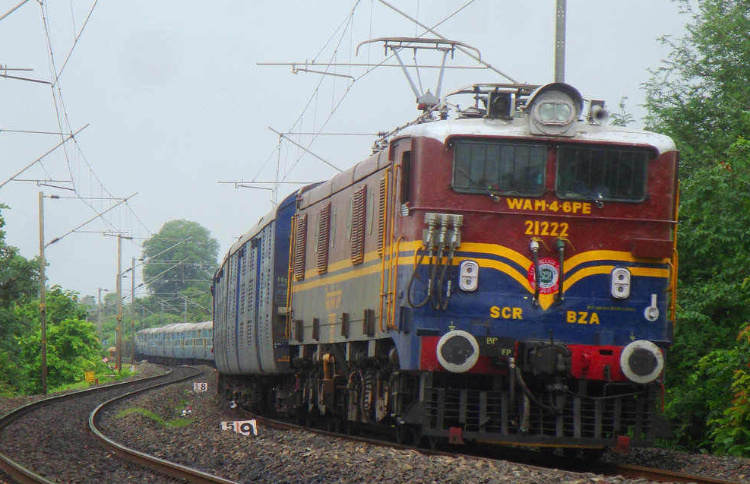
This class proved so successful by virtue of its ruggedness suitable for Indian conditions and simplicity of maintenance, that IR used this basic design for a number of other locos later (WCAM-1, WAG-5A, WCG-2, and some WAP models). Given how long they were in production, a large number of variants existed, both serially produced and modified by various sheds and workshops. WAM-4B's were regeared versions for freight use and many were later modified and converted to other classes (See below). WAM-4P locos were intended for passenger operations, with some regearing and usually allowing all-parallel operation of some or all of the traction motors. WAM-4P D (dual brakes), WAM-4P DB 6P, WAM-4 6P DB HS, and WAM-4 6P D (these were for superfast trains), WAM-4P DB 3P and WAM-4 2S-3P (some superfasts, passengers), and WAM-4P DB 4P (generally for stopping passengers). The 'DB' or 'D' generally, but perhaps not always, indicates dual-brake capability. 'HS' for 'high speed'.
'2S', '3P', '6P', etc. indicate traction motors connected in series or parallel. The WAM-4 has six traction motors, and originally they were wired to be available in different configurations at different power settings. At notches up to 14, all motors were in series (at notch 14 all resistors dropping out); up to notch 21 in series-parallel combinations (three pairs of motors in series, the pairs themselves being in parallel); and further notches with all motors in parallel (at notch 30 all motors are in parallel with resistors dropping out). The WAM-4 locos were later reconfigured to have all motors always in parallel (6P variants) or with the three series-connected pairs in parallel (2S 3P variants). Some WAM-4 locos from CLW were thought to have had the 2S 3P configuration right from the start. The 2S 3P configuration was better for the mixed traffic loads especially as it allowed the locos to start hauling larger loads without stalling. With increasing use of the WAM-4 locos for passenger traffic the all-parallel configuration was deemed more desirable since it allowed higher speeds and higher acceleration. Some other odd combinations of these suffixes have been sighted, such as WAM 4+6P+DB+HS and WAM-4 6P-E.
Many WAM-4 had their MU capability disabled for a long time, before the Tughlakabad shed began restoring them for its fleet to handle high speed container freight operations. WAG-5/WAG-5B locos with road numbers 21101 to 21138 all used to be WAM-4B locos. They were regeared and modified to be suitable for hauling heavier freight loads.
With the introduction of dedicated passenger and freight locos from the mid-90s, these locos began seeing decreasing use, often relegated to either shunting or short distance passenger running. Many sheds began scrapping their holdings from 2013 onwards. As of August 2022, there are only 8 of this class left, all in inferior service at sheds and workshops. These are expected to be scrapped soon. A few of them have been preserved or plinthed at various locations on IR (Bhusawal, Jhansi, Hubballi, CLW etc.)
| Builders | CLW |
| Traction Motors | Alstom TAO 659 A1 (798hp, 750V, 840A, 1095rpm, 2800kg) |
| Gear Ratio | 15:62 originally; 21:58 for WAM-4P later |
| Transformer | HEIL (later BHEL) BOT 3460 A, 22.5kV/3460kVA |
| Rectifiers | Two silicon rectifier cells, 1270V/1000A each cubicle |
| Pantographs | Two Faiveley AM-12 |
| Horsepower | 3690hp continous |
| Axle Load | 18.8t |
| Bogies | Co-Co trimount (ALCo) |
| Weight | 112.8t |
| Starting TE | 30 tons |
| Max. Speed | 120km/h |
| Length Over Buffers | 19975mm |
These were IR's only mainline metre gauge AC electric locomotives. 20 in number (18 ordered first, two later) were supplied by Mitsubishi in 1964 and worked the line between Madras and Villupuram on SR. 1600hp locos with B-B monomotor bogies (DC motors permanently coupled in parallel). Air brakes for loco, vacuum train brakes. Oerlikon compressor and exhauster, Arno rotary convertors.
They were in service until 2004 when their operating lines were converted to broad gauge. On June 30, 2004, the last YAM-1 run took place, minutes after the last MG EMU service on the Chennai network reached the Tambaram station. Two of this class are preserved – one at CLW (#21912) and one at the Regional Museum at ICF, Chennai (#21909).
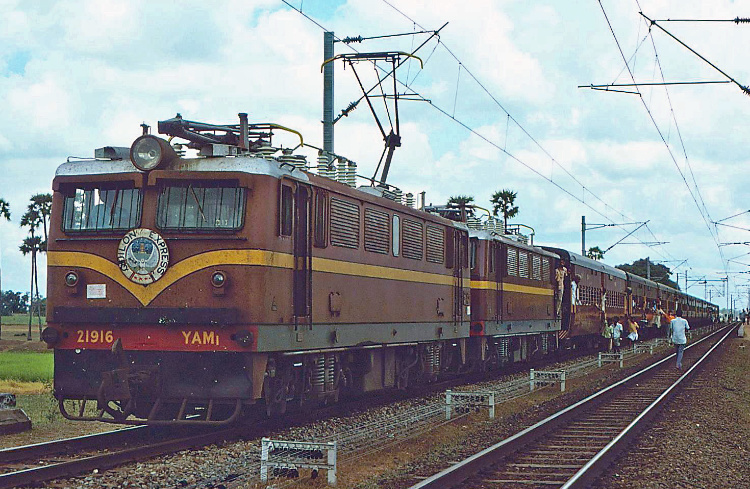
| Builders | Mitsubishi |
| Traction Motors | ACEC/Alstom/Siemens MG1420. Fully suspended, force-ventilated. 5600kg. 1080kW, 1250V, 920A, 630 rpm |
| Gear Ratio | 3.95:1 |
| Transformer | Mitsubishi 'Shell Sub', 1690kVA, 25 taps |
| Rectifiers | Secheron excitron rectifiers, type A268 (four), 510A/1250V |
| Pantographs | Two Faiveley AM-12 |
| Horsepower | 1600hp |
| Axle Load | 13t |
| Bogies | B-B (monomotors) |
| Weight | 52t |
| Starting TE | 19.5 tons |
| Continuous TE | 13.6 tons |
| Max. Speed | 80km/h |
| Length Over Buffers | 13150mm |
Dedicated Passenger Locomotives
Built by CLW to RDSO specifications beginning in 1980, these were the first in the dedicated electric passenger loco series. These locos were used solely for the Howrah-Delhi Rajdhani at first. A single WAP-1 (#22001) was all that was needed to haul the 18-coach Rajdhani at a max. speed of 120 km/h. Power 3760hp; starting TE 22.4t, continuous TE 13.8t. Loco weight is 112.8t. Motors are grouped in 2S-3P combination and weak field operation is available. Elgi compressors, Northey exhausters, S F India blowers. The locos were originally not designed for MU operation but were later modified to allow MU'ing. Loco air brakes and vacuum train brakes but retrofitted for dual train brakes later.
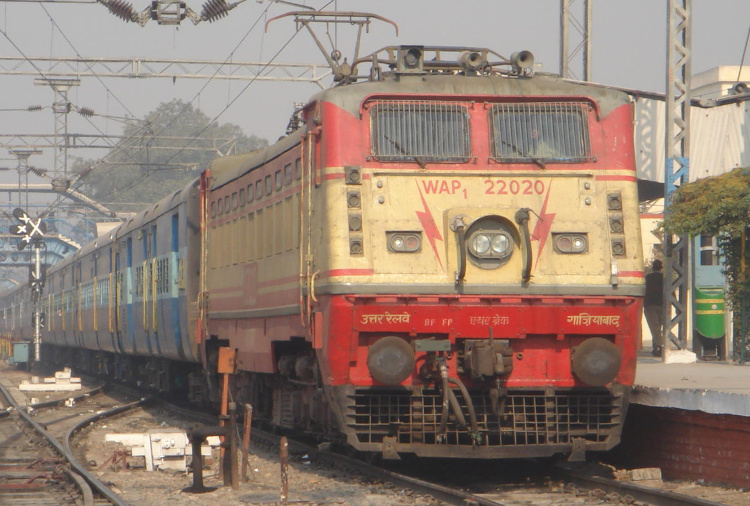
The original WAP-1 locos were modified and re-geared versions of the WAM-4, classified as WAM-4R. Rated max. speed is 130km/h (some documents suggest 140km/h). Some (5?) with Flexicoil Mark II bogies were classified WAP-1 FM II and later WAP-3. Two WAP-1 units were also converted to WAP-6. One of them, #22212, the first prototype WAP-6, was then converted to a WAP-4. Many WAP-1 were converted to WAP-4's by a complete retrofit including new traction motors, new transformers, etc. These upgrades did not result in the 'R' suffix in the road number that is typical for rebuilt locos. Of the class that remain as WAP-1, almost all have had large modifications made to their shell - redesigned frame around the wheels, top mounted headlights, wider and taller windscreens etc.
As of August 2022, 59 of this class are still in service, mostly at Erode and Izzatnagar sheds, with many on the verge of retirement given their age. One, #22004 is preserved at the Arakkonam shed.
Variants
WAP-3: Originally classified as WAP-1 FMII, these are essentially same as WAP-1 but with different Flexicoil bogies (Flexicoil Mark II for the earlier ones, and Flexicoil Mark 4 (fabricated bogies) for some of the later ones, etc.). The first WAP-3 "Jawahar", #22005, Jan. 4, 1987) was used for the Taj Exp. These locos could only haul 19-coach rakes for the Rajdhani and other prestigious Express trains for which they had been designed, and further required assisting locos on moderately graded sections, and so did not meet their design goals. Max. speed 140km/h. All units were converted back to the WAP-1 beginning 1997.
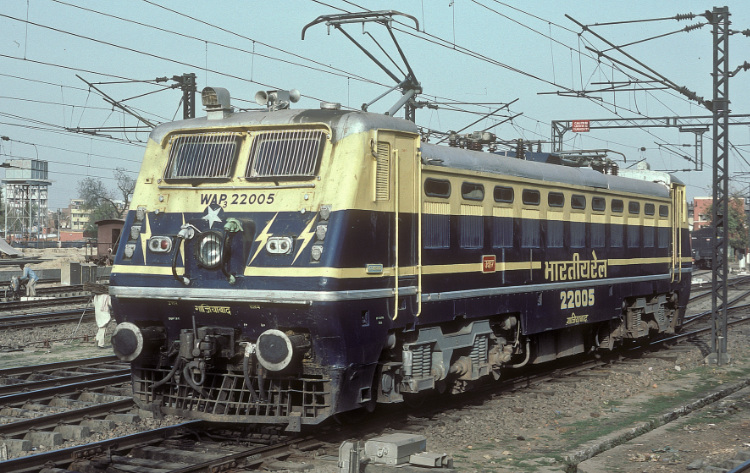
| Builders | CLW |
| Traction Motors | Alstom/CLW - TAO 659 (770hp, 750V, 1095 rpm) Axle-hung, nose-suspended, force-ventilated |
| Gear Ratio | 58:21 |
| Transformer | BHEL type HETT-3900, 3900 kVA, 32 taps |
| Rectifiers | Two silicon rectifiers, with S18FN35 cells (by Hind Rectifier) with 64 cells per unit. 2700A/1050V |
| Pantographs | Two Faiveley AM-12 |
| Horsepower | 3900hp (3790hp continuous) |
| Axle Load | 18.05t |
| Bogies | Co-Co Flexicoil (cast steel bogies); primary and secondary wheel springs with bolsters |
| Weight | 108.3t |
| Starting TE | 22.4 tons |
| Continuous TE | 13.8 tons |
| Max. Speed | 130km/h |
| Length Over Buffers | 18794 |
These were a very odd experimental class. A few WAM-2 were re-geared and fitted with modified flexicoil fabricated bogies to increase their speeds and stability. These locos were found only on ER. On rare occasions these locos were used to haul the Howrah Raj in the early 1980s. There are thought to have been only 4 of these, and they were decommissioned in the late 1980s.
Built between 1994 and 2015, these are the more powerful cousins of the WAP-1, with Hitachi H5 15250 motors. 5000hp (later 5350hp). Rated at 140km/h. The need to run longer passenger trains (24 to 26 coaches as against the 19-coach capacity of the WAP-1/WAP-3 locos), and also to eliminate the need for bankers in graded sections led RDSO to consider an upgraded design of the WAP-1 loco and the WAP-4 loco design was published in November 1993. Indigenously designed higher power rated silicon rectifiers and 5400kVA transformer. Locomotive reliability is also increased by the use of Hitachi traction motors. Air brakes for loco and train. Different underframe design to handle larger buffing loads. Cast bogie, Flexicoil Mark 1 design. Weight kept to 112t by the use of aluminium plates, thinner underframe, and reducing some components such as extra sanders. Motors grouped in 6P combination; weak field operation possible.
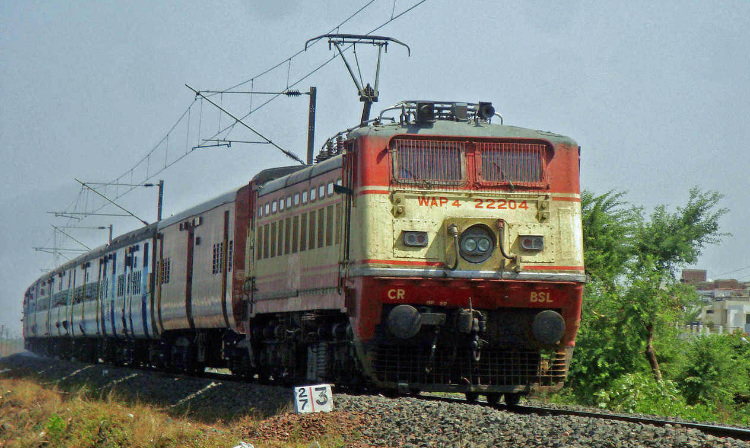
These locos underwent many minor modifications throughout their production run. In 2000, twin-beam headlights were added. In the mid-2000s, they started being fitted with train-parting/pressure loss alarms, and data recorders for speed, energy consumption, etc. These locos also feature roof mounted twin beam headlights, square WAP-5 type windscreens and a digital notch repeater along with a better layout and good seats for the drivers. A few were provided with signalling lamps on the sides but this does not have seem to have been uniform.
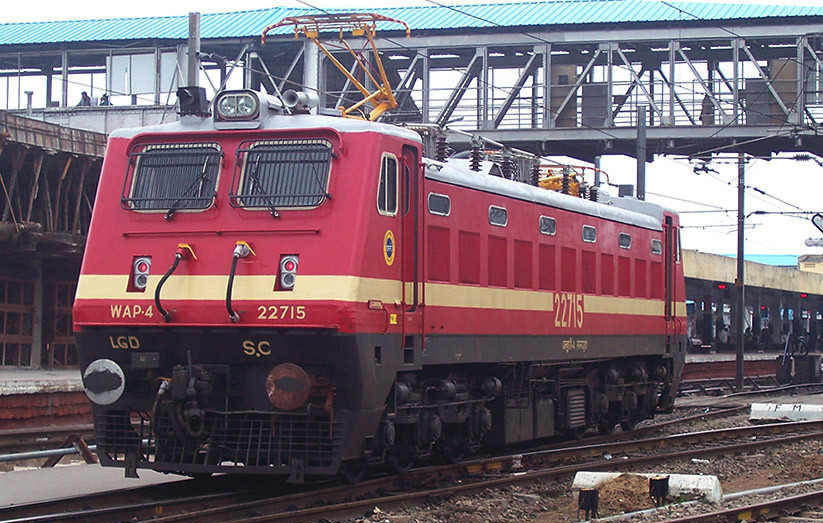
There are over 700 of this class still in operation as of February 2022, hauling mostly trains running with ICF stock. A few experiments to fit them with hotel load capabilities did not succeed so they are not often assigned to LHB stock (with run with HOG capable WAP-7). The first batch of WAP-4 were multi-unit capable, but most of the newer ones aren't. However, starting in 2020, there have been directives to revive or retrofit MU capabilities in these locos. With their dwindling passenger train use, it was felt that they might be used MU'ed for fast freight operations.
Note on the traction motors: The Alstom-designed 770hp TAO motors used in the WAP-1 and WAP-3 were seen as the weak link in the reliability of the locos for passenger train use. At the time, Hitachi motors of 840hp were in use on freight locos and had very high reliability, but adapting them for use with a passenger loco proved a formidable challenge because of the weight constraints. The WAP-4 design efforts involved many modifications for weight reduction, including a lighter underframe, aluminium foil-wound transformer, and the use of aluminium chequered plates, and these have allowed the use of the heavier, but more powerful and more reliable Hitachi motors on the WAP-4 locos.
Variants
WAP-6: All are now converted back to WAP-4. One or two prototypes were built early from existing WAP-1 or WAP-4 locos without renumbering. WAP-4 #22212 (formerly a WAP-1) was the first to be converted to a WAP-6; Later 16 were built, all in the number series 22400-22416. All featured high-adhesion fabricated bogies (Flexicoil Mark IV) which are somewhat similar to the ALCo Hi-Adhesion bogies, a lighter underframe, reduced no. of sanders etc. They were intended for service at 160km/h but failed trials and were restricted to a top speed of 105km/h. They were all based at Asansol shed (on ER).
| Builders | CLW |
| Traction Motors | Hitachi HS15250 (630kW, 750V, 900A. 895rpm. Weight 3500kg). Axle-hung, nose-suspended, force ventilated, taper roller bearings. |
| Gear Ratio | 23:58 |
| Transformer | HETT-5000kVA initially, later HETT-5400kVA; 32-taps |
| Rectifiers | Two silicon rectifiers; S18FN350 cells (Hind Rectifier or Stesalit) with 64 cells per unit. 2700A/1050V. |
| Pantographs | Two Stone India AM-12 (many types later - Schunk, Faiveley, Contransys) |
| Horsepower | 5000hp (later 5350hp) |
| Axle Load | 18.8t |
| Bogies | Co-Co Flexicoil Mark-1 cast |
| Weight | 112.8t |
| Starting TE | 30.8 tons |
| Continuous TE | 19.6 tons |
| Max. Speed | 140km/h (Tested at 169.5km/h) |
| Length Over Buffers | 18794 |
Bo-Bo, 3-phase all AC locomotives, based on Swiss Lok 2000 design. First batch of 10 were imported from ABB/AdTranz in 1995 (actually 11, but one #30008 was damaged by fire in transit and deemed unusable on arrival.) CLW has since been manufacturing them. Initial units all had GTO thyristors for traction control, but units post #30082 are IGBT based. Rated top speed is 160km/h, although in trials a WAP-5 loco is said to have been run at 184km/h. Initial rating was 5450hp, but improvements to the control software have resulted in power delivery of 6000hp to the wheels. Auxiliaries from ABB, Howden Safanco, BEHR, etc. 78t weight. Fully suspended motors.
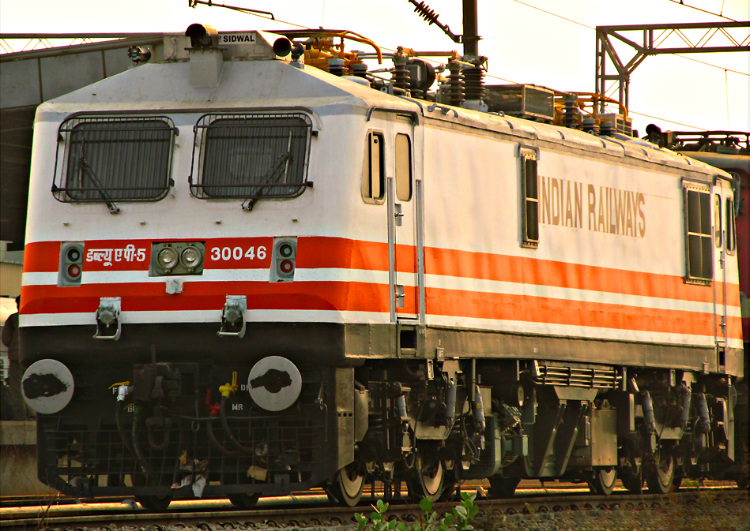
Other notable features of this loco are the provision of taps from the main loco transformers for hotel load, pantry loads, flexible gear coupling, wheel-mounted disc brakes, and a potential for speed enhancement to 200km/h. Braking systems include regenerative braking (160kN), loco disc brakes, automatic train air brakes, and a charged spring parking brake. MU operation possible with a maximum of two locos. Initially, these locos were intended for use with high-speed medium load trains such as the Rajdhani and Shatabdi trains, but have since been used on heavier loads. They were originally only homed at Ghaziabad shed (NR), but Vadodara (WR) started receiving a large number of them when the Mumbai network became all AC. They are now also now based at Howrah.
After the first four were built by CLW, there was a pause in the manufacture of this class at CLW. A problem with the Hurth coupling and its indigenous replacement were the cause of the delay (IR not wanting to import this expensive component and drive up manufacturing costs.) In late 2014, locally manufactured components passed trials and production was resumed.
#30086 has a different gear ratio (59:35:19) and control software intended for operations at 200km/h. No actual trials have taken place at that speed, as no current permanent way supports such a speed. #30164 features a more aerodynamic profile, ostensibly to run at higher speeds. In October 2020, #35012 & #35013 were manufactured with one cab having an aerodynamic profile, while the other having a flat front. These were intended for use on Tejas Expresses in a push-pull configuration, but no actual run in this style has taken places. Both these locos are now being used to haul regular express and passenger trains.
| Builders | ABB/CLW |
| Traction Motors | ABB 6FXA 7059 3-phase squirrel cage induction motors (1150kW, 2180V, 370/450A, 1583/3147 rpm). Forced-air ventilation, fully suspended. |
| Gear Ratio | 67:35:17 (3-stage gears) |
| Transformer | Type LOT-7500 by ABB, Hi-Volt, BHEL |
| Power Convertor (original GTO) | Power convertor from ABB, type UW-2423-2810 with SG 3000G X H24 GTO thyristors (D 921S45 T diodes), 14 thyristors per unit (two units). Line convertor rated at 2 x 1269V @ 50Hz, with DC link voltage of 2180V. Drive convertor rated at 2180V phase to phase, 953A output current per phase, motor frequency from 0 to 160Hz. |
| Pantographs | Two Faiveley AM-92 (many types later - Schunk, Stone India, Contransys, Brecknell Willis) |
| Horsepower | 6000hp (5450hp originally) |
| Axle Load | 19.5t |
| Bogies | Bo-Bo Henschel Flexifloat |
| Weight | 78t |
| Starting TE | 26.3 tons |
| Continuous TE | 22.4 tons |
| Max. Speed | 160km/h |
| Length Over Buffers | 18162mm |
IR's modern workhorse loco. First introduced in 2000, there are now over 1400 in service making them the most numerous passenger locomotive. Based on the WAG-9 (see below), with modified gear ratio, control software and reduction in weight. Initial models were rated at 6125hp total power and 33000 kgf (323kN) tractive effort. Modifications during continuing trials resulted in improved performance with the loco now yielding 6350hp total power and 36000 kgf (352.8kN) tractive effort. Braking systems as in the WAP-5, with regenerative braking rated at 183kN in the first units and 260kN in the later ones. Max. tested speed is 160km/h, rated for 140km/h.
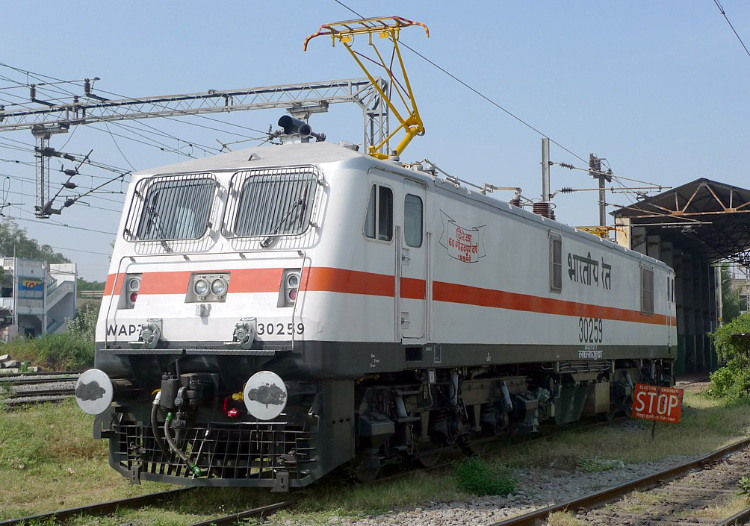
Like the WAP-5, all initial ones featured GTO based traction control systems, but IGBT based ones started appearing in the early 2010s. These were given the subclass WAP-7i initially, but with all locos being manufactured with IGBT controllers subsequently, this has been done away with, and all locos are classed WAP-7. Early units also did not have hotel load capability, but starting 2015, this became part of the standard equipment. Older locos are being retrofitted with the capability during overhauls. Some locos are also push-pull capable (Kalyan shed has a pair of these (#30579, #30580) that haul CR's Rajdhani Express to H.Nizamuddin.) Recent units also feature one high-rise pantograph as original equipment in case they are needed to service lines that act as feeders to the Western DFC.
Variants
WAP-7HS: HS for 'High Speed'. This is a one-off variant (#30750) designed in 2019 to increase the base model's max. speed to 180km/h and make it possible to haul 24-coach loads at 160km/h. Loco weight has been reduced by 14.5t (how??); Max. axle load reduces to 18.08t; Changed gear ratio (70:22); Tweaks to the control software. Trials were conducted at 180km/h on the Kota-Sawai Madhopur section on WCR. It is not clear if these trials were successful and if more of this variant is being considered for serial production. #30750 continues to haul trains at a max of 130km/h.
| Builders | CLW |
| Traction Motors | 6FRA 6068 3-phase squirrel-cage induction motors (850kW, 2180V, 1283/2484 rpm, 270/310A). Forced ventilation, axle-hung, nose-suspended. |
| Gear Ratio | 72:20 |
| Transformer | Type LOT-7500/7775 by ABB, Hi-Volt, BHEL |
| Power Controller | GTO: UW-2423-2810 with SG 3000G X H24 GTO thyristors from ABB; IGBT: 5SNA 1200G450300 from BHEL, MEDHA |
| Pantographs | Two Secheron 103-2500 (many types later - Schunk, Stone India, Contransys, Faiveley) |
| Horsepower | 6350hp |
| Axle Load | 20.5t |
| Bogies | Co-Co, ABB bogies |
| Weight | 123t |
| Starting TE | 36 tons |
| Max. Speed | 140km/h |
| Length Over Buffers | 20562mm |
Dedicated Freight Locomotives
Among the first AC electrics to run in India. These were a dedicated freight followup to the mixed use WAM-1. The first 30 were made by the 50 Cycles European group, with the rest made by CLW using supplied kits. 2850hp, monomotor bogies with B-B wheel arrangement, Jacquemin drives (?) and excitron rectifiers. Motors are permanently coupled in parallel, with speed control by transformer taps. Air brakes for loco, vacuum train brakes as original equipment. Regenerative braking provided. Typically French features include elongated 'D'-shaped buffers. The Indian modifications included addition of a cowcatcher, CBC couplers, and a large roof-mounted searchlight-style head lamp. Although sterling performers, some of their highly advanced features such as the spring-borne traction motors, etc., did not suit Indian conditions.
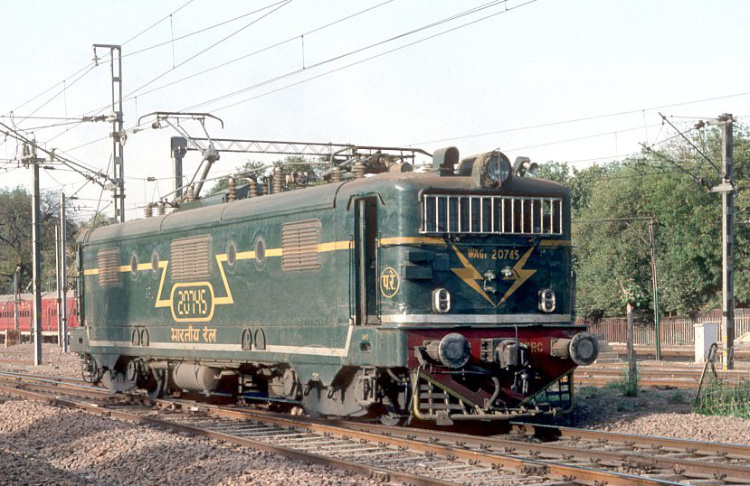
Several were based at Arakkonam, Vijayawada, Baroda, and other places. Most were decommissioned by the 1990s, although a few were seen still in use in 2000 or so. Two units (the last ones, #20790, #20791) built by CLW in 1964 were denoted WAG-1S; it is not clear how they were different from the others.
| Builders | 50 Cycles Group, CLW |
| Traction Motors | AEC/Alstom/Siemens MG1420. Two motors (monomotor bogies), force-ventilated, fully suspended. |
| Gear Ratio | 3.95:1 |
| Transformer | MFO, type BOT 3150. 22.5kV/3000kVA. 32 taps |
| Rectifiers | Four Secheron A268 excitrons, 510A/1250V |
| Pantographs | Two Faiveley AM-12 |
| Horsepower | 2850hp |
| Axle Load | 21.3t |
| Bogies | B-B (monomotors) |
| Weight | 85.2t |
| Starting TE | 30 tons at 35% adhesion |
| Continuous TE | 23.7 tons |
| Max. Speed | 80km/h |
| Length Over Buffers | 17092mm |
Made by Hitachi, they were the alternative to the European WAG-1. 45 of these were delivered between 1964-1965 (IR numbers 20804-20848). B-B bogies, monomotor design with motors permanently coupled in parallel, silicon rectifiers, rheostatic braking provided, Westinghouse compressor, Northey exhauster. These were based at Asansol on ER when they were inducted, and regularly hauled both freight and ordinary passenger trains. They were moved to Bhusawal and Itarsi sheds on CR in the early 1980s from where they retired in the late 1990s. None of them have been preserved.
| Builders | Hitachi |
| Traction Motors | Hitachi EFCO HKK (1270kW, 1250V, 1080A, 695rpm, weight 5300kg) |
| Gear Ratio | 3.88:1 |
| Transformer | Hitachi AFI-AMOC, 3700kVA, 32 taps |
| Rectifiers | AEV-48 silicon rectifiers, 2040A / 2550kW |
| Pantographs | Two Faiveley AM-12 |
| Horsepower | 3400hp |
| Axle Load | 21.3t |
| Bogies | B-B (monomotors) |
| Weight | 85.2t |
| Starting TE | 30 tons at 37% adhesion |
| Continuous TE | 22.6 tons |
| Max. Speed | 80km/h |
| Length Over Buffers | 16882mm |
10 of these locos were supplied by the 50 Cycles group in 1965. 3150hp, B-B monomotor bogies, silicon rectifiers, air loco brakes, vacuum train brakes and rheostatic braking. MU operation of upto 4 were possible. These are essentially the precursor to the indigineously assembled WAG-4 (see below).
186 were built between 1967 and 1969 by CLW, with equipment from the 50 Cycles group. The DC traction motors for these were the first to be manufactured indigenously by CLW. Other auxiliary components were also made domestically. Most of these locos were based at Kanpur shed on NR. B-B monomotor bogies, silicon rectifiers, air loco brakes, vacuum train brakes, rheostatic brakes. Upto four locos could be operated as multi-unit. Some locos were converted to dual brake systems. While they were primarily freight locomotives, they were also used to haul short-haul passenger trains.
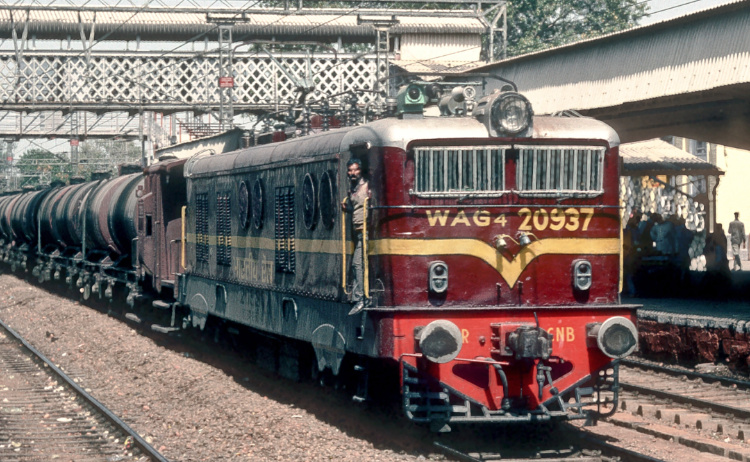
| Builders | CLW |
| Traction Motors | AGEC MG 1580 A1 (1160kW, 1270V, 1040A, 690 rpm, weight 5850kg). Fully suspended, bogie-mounted. |
| Gear Ratio | 3.95:1 |
| Transformer | Oerlikon BOT 3460, 32 taps |
| Rectifiers | Two GL 82220 silicon rectifiers, 1000A/1270kW/1270V |
| Pantographs | Two Faiveley AM-12 |
| Horsepower | 3150hp |
| Axle Load | 21.9t |
| Bogies | B-B (monomotors) |
| Weight | 87.6t |
| Starting TE | 30 tons at 34% adhesion |
| Continuous TE | 23.2 tons |
| Max. Speed | 80km/h |
| Length Over Buffers | 17216mm |
The initial batch of these were actually re-geared WAM-4 locos classified WAM-4B (#21100-#21138). Serial production with a slightly modified traction motor (3900hp vs 3850hp), heavier frame to improve adhesion etc. began in 1984. Co-Co bogies based on ALCo trimount design. TE 382kN (33500kgf); continuous TE 202kN (20600kgf). Adhesion 29%. A very successful class, and probably the one with the most numbers produced. There are many variants of these, starting with the plain WAG-5. WAG-5A locos have Alsthom motors. Later versions were WAG-5H and variants with Hitachi motors: WAG-5HA by CLW and WAG-5HB built by BHEL to RDSO's specifications.
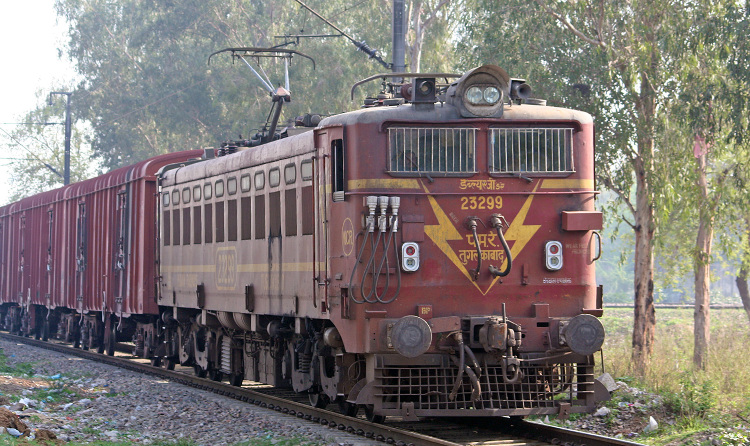
Auxiliaries are from many sources: typically Elgi compressors, Northey exhausters, and other equipment from S F India, but many variations exist. Speed control by parallel combinations of motors and weak field operation. Air brakes for loco, dual train brakes are original equipment. Equipped for rheostatic braking. The original WAG-5 units had a top speed of 80km/h. Many variants have a gear ratio of 21:58, the same as that of the WAM-4 6P, which allows these WAG-5 locos to be used for mixed applications including hauling passenger trains at 100km/h.
Although a great improvement over earlier locomotive classes, the WAG-5 models do have limitations, one of which is the inability to start and haul large loads (4700t -- 58 BOXN wagons) on gradients steeper than 1:200 or so. WAG-5 locos can be used as multiple units in configurations of 2, 3, 4, or more locos. With the large influx of WAG-7 and WAG-9 locos in recent years, use of these locos has steadily declined, with many being scrapped. As mentioned above, some WAG-5 with modified gear ratios haul local passenger trains, but as EMUs take over these kinds of trains, their use in such cases has also declined.
| Builders | CLW, BHEL |
| Traction Motors | Alstom TAO 659 (575kW, 750V, 1070 rpm) or TAO 656 or Hitachi HS 15250A; Axle-hung, nose-suspended. Six motors. |
| Gear Ratio | 62:16 or 62:15 with Alstom motors, some 64:18 (Hitachi motors), many now 58:21 for mixed use |
| Transformer | BHEL, type HETT-3900. 3900kVA, 22.5kV, 182A. 32 taps |
| Rectifiers | Silicon rectifiers (two) using 64 S-18FN-350 diodes each from Hind Rectifier, 2700A/1050V per cubicle |
| Pantographs | Two Faiveley AM-12 |
| Horsepower | 3900hp |
| Axle Load | 19.8t |
| Bogies | Co-Co cast bogies (ALCo trimount) |
| Weight | 118.8t |
| Starting TE | 33.5 tons at 29% adhesion |
| Continuous TE | 20.6 tons |
| Max. Speed | 100km/h |
| Length Over Buffers | 19974mm |
These are actually three distinct types of locomotives, oddly assigned a single class! WAG-6A models are from ASEA, while WAG-6B and WAG-6C are from Hitachi. They are all 6000hp locos with thyristor-controlled DC traction motors. Until about 1993 they were the most powerful freight locos in IR's fleet. The development of this technology (chopper control) stopped when the (better) AC motor technology was introduced in IR in the form of the WAP-5 and WAG-9 locomotives.
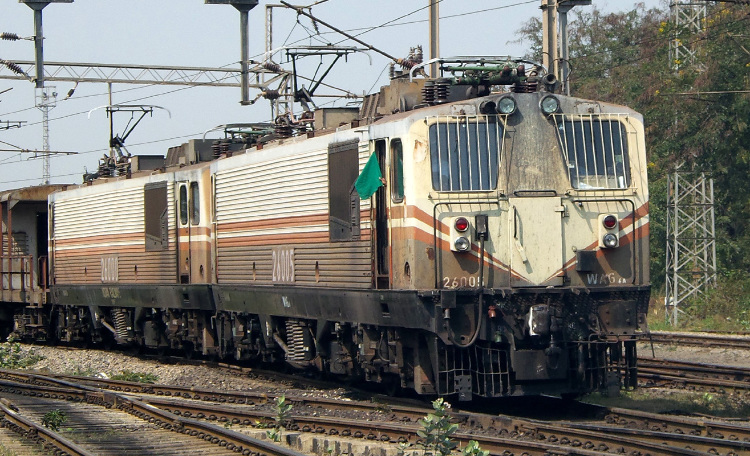
WAG-6A and WAG-6B locos have Bo-Bo-Bo wheel arrangements, whereas the WAG-6C locos have a Co-Co arrangement. Six bogie-mounted separately excited DC traction motors are used, and speed control is via the manipulation of the phase angle by a thyristor converter and a separately powered field coil. Microprocessor control with ground speed detection (slip control) and creep control system to maximize adhesion. Air brakes for loco and train; dynamic brakes provided. The WAG-6 series locos are the only ones with 'vestibules' to connect between MU'd locos. WAG-6A locos have half-height vestibules and WAG-6B and WAG-6C locos have full-height vestibules. The WAG-6A models are said to be upgradable to 160km/h but IR never tried this out. All WAG-6 variants can be used in MU pairs but not with more than 2 locos.
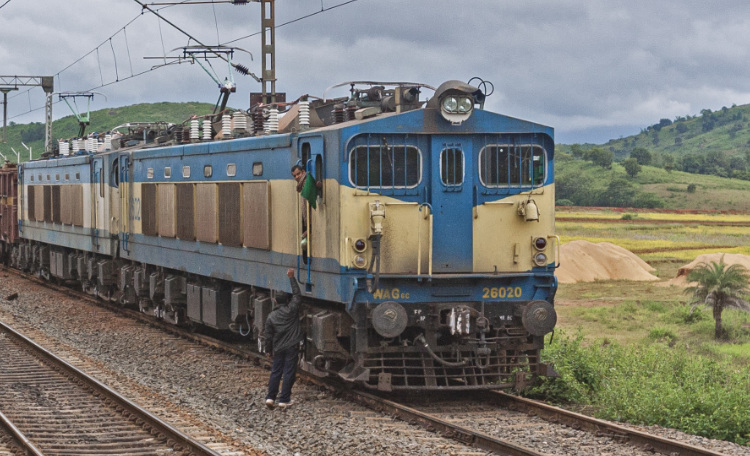
The WAG-6A body shells were built by SGP in Austria; the rest of the locos were built and the entire units assembled in Västerås, Sweden by ASEA. ASEA constructed a special length of 1.67m (BG) track for testing these before delivery. The locos were fitted with BG bogies at Göteborg harbour after being transported there on standard gauge bogies. The first WAG-6A was delivered around December 1987 and the remaining five in January 1988.
All WAG-6 locos are based at Waltair (Vishakapatnam) shed and have been used used for ore freights and material trains on the Kirandul-Kottavalasa line. They were in regular use until 2000 when maintenance problems began affecting their use. In Oct. 2002 the WAG-6A were technically suspended from operations for POH for a while. Most of the WAG-6B and WAG-6C were also similarly suspended at different times. However, they were revived soon and continued service for a few more years until about 2015. With the influx of modern WAG-9 locos, the WAG-6 were soon relegated to odd shunting jobs around marshalling yards near Vishakapatnam. Out of the 18 locomotives of this class, only 5 are in service as of February 2021 (2 WAG-6B, 3 WAG-6C). One each of the various sub-classes are preserved at the Waltair shed (#26000 WAG-6A; #26010 WAG-6B; #26020 WAG-6C).
| Builders | WAG-6A: ASEA; WAG-6B/6C: Hitachi |
| Traction Motors | WAG-6A: ASEA L3 M 450-2; Six motors, fully suspended, force-ventilated, separately excited, 3100kg; WAG-6B: Hitachi HS 15556-OIR, bogie mounted, force-ventilated, compound-wound, 3200kg; WAG-6C: Hitachi HS 15256-UIR, axle-hung nose-suspended, force-ventilated, compound-wound, 3650kg |
| Transformer | WAG-6A: ASEA TMZ 21, 7533kVA; WAG-6B/6C: Hitachi AFIC-MS, 6325kVA |
| Thyristor Controller | WAG-6A: 24 YST 45-26P24C thyristors each with 24 YSD35-OIP26 diodes, 2x511V, 2x4500A; WAG-6B/6C: 32 CGOIDA thyristors each with 24 DSP2500A diodes. 2x720A, 850V |
| Pantographs | WAG-6A: Two Stemman BS 95; WAG-6B/6C: Two Faiveley LV2600 |
| Horsepower | WAG-6A: 6280hp; WAG-6B/6C: 6050hp |
| Axle Load | WAG-6A: 20.5t; WAG-6B/6C: 20.5t |
| Bogies | WAG-6A: Bo-Bo-Bo; WAG-6B: Bo-Bo-Bo; WAG-6C: Co-Co |
| Weight | WAG-6A: 123t; WAG-6B/6C: 123t |
| Starting TE | WAG-6A: 46 tons; WAG-6B/6C: 45 tons |
| Continuous TE | WAG-6A: 32 tons; WAG-6B/6C: 32 tons |
| Max. Speed | WAG-6A: 120km/h; WAG-6B/6C: 100km/h |
| Length Over Buffers | WAG-6A: 20600mm; WAG-6B/6C: 19700mm |
Built by CLW to RDSO specifications, these represent the next indigenous design step up from the WAG-5 locomotives. Used primarily for goods haulage, these locos have a Co-Co wheel arrangement with high-adhesion bogies (shared with WCAG-1, WCAM-3, WDG-2/3A) and Hitachi motors providing 5000hp. Starting TE 402kN (41000kgf); continuous TE 235kN (24000kgf). Adhesion 34.5%. The higher tractive effort compared to the WAG-5 locos allows them to attain higher balancing speeds under load. The first 71 of these all went to the Mughalsarai shed. Kanpur was the second shed to get these locos.
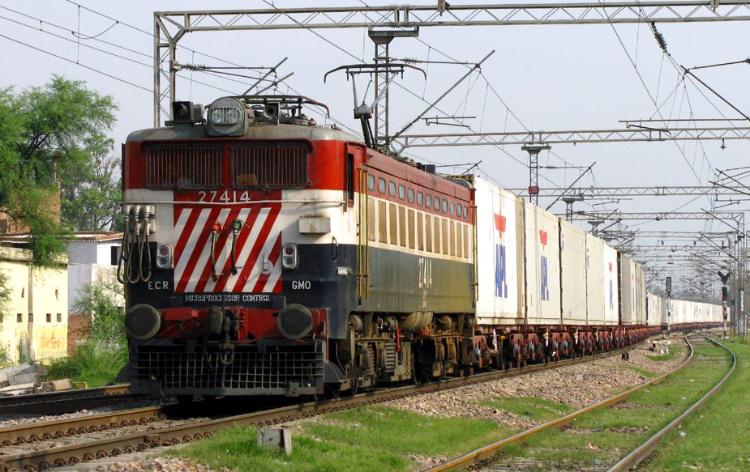
Traction motors are permanently coupled in parallel. Max. speed is 100km/h. Air brakes and dynamic (rheostatic) brakes for loco, dual train brakes. MU operation with up to 4 units is possible. Traction equipment such as the smoothing reactor, etc., are all higher rated than in the WAG-5 due to the higher currents this loco draws. Auxiliaries include Rigi compressor, Arno rotary converters, Siemens smoothing reactor, Northey exhauster; other auxiliaries such as blowers from S F India. A number of these locos have been retrofitted with static converters to power the auxiliaries, replacing the older Arno rotary converters. These static converters are more efficient and require less maintenance, besides having self-diagnostic systems to make troubleshooting easier.
Two locomotives in this class were designated WAG-7H. experimentally modified to provide higher TE by increasing their weight. Oscillation trials were conducted on a ballasted WAG-7 (#27002) around 1995, and then a new WAG-7 loco was built by CLW to have higher weight using thicker plates in the underframe of the loco (#27061, 1995). Weight is 132t, max. TE 441kN (45000 kgf). Traction motors are Hitachi HS15250-G, perhaps a minor variant of HS15250.
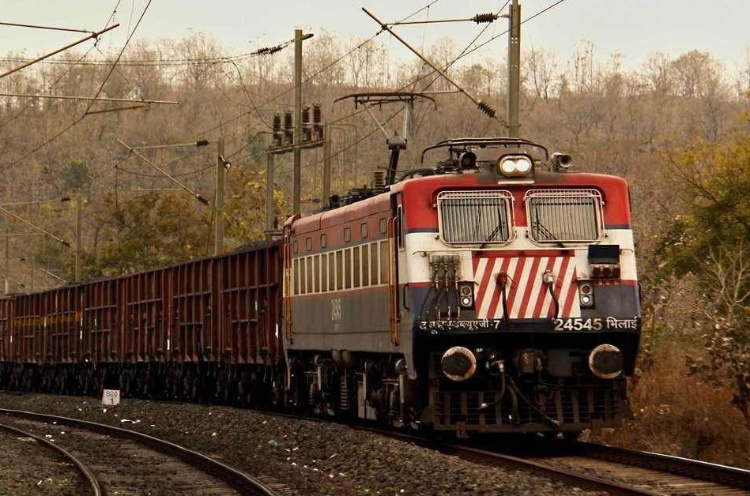
In 2008, these locos underwent minor internal changes and extensive cosmetic ones. The flat fronted cab gave way to the sloped profile from the WAP-4 which made the cab larger and shifted certain components inside the machine room. Also in 2008, BHEL started manufacturing these according to specs from RDSO. These locos (in the 245xxx number range) carried over the new shell design, but had significant changes inside the cab – joystick for the master controller instead of the wheel, air-conditioning as standard, improved 3-way adjustable seats etc. Serial production of this class stopped in 2015 (in favour of the 3-phase WAG-9).
| Builders | CLW |
| Traction Motors | Hitachi HS15250-G (630kW, 750V, 900A. 895rpm. Weight 3650kg). Axle-hung, nose-suspended, force ventilated, taper roller bearings. |
| Gear Ratio | 65:18 |
| Transformer | CCL India, type CGTT-5400, 5400kVA, 32 taps |
| Rectifiers | Two silicon rectifiers, cell type S18FN350 (from Hind Rectifier), 64 per bridge, 2700A / 1050V per cubicle |
| Pantographs | Two Stone India AN-12 |
| Horsepower | 5000hp |
| Axle Load | 20.5t |
| Bogies | Fabricated Co-Co high-adhesion based on ALCo design |
| Weight | 123t |
| Starting TE | 41 tons at 34.5% adhesion |
| Continuous TE | 24t |
| Max. Speed | 100km/h |
| Length Over Buffers | 20934mm |
These were an experimental class built by BHEL in 1996. Only two were made, with no IR running numbers. Similar appearance to the WCAM-2/3 locos. 5000hp with thyristor chopper control of DC motors with Flexicoil Mark IV high-adhesion bogies. These locos were designed to be the next evolution of the WAG-7, with some of the more sophisticated technology borrowed from the WAG-6. Both units now lie mothballed at a siding at BHEL's plant in Bhopal.
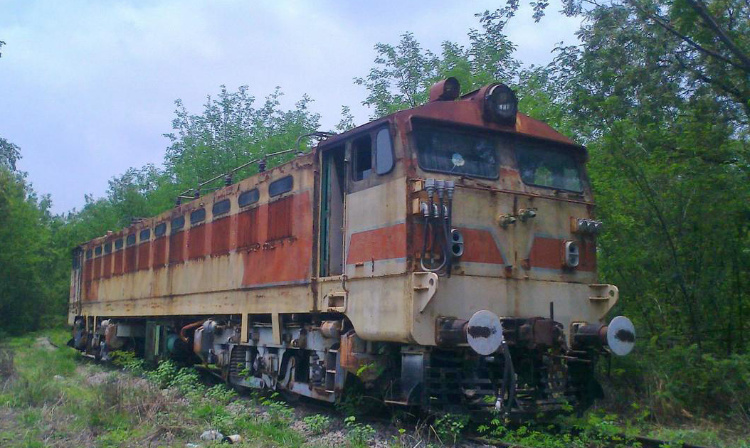
IR's workhorse electric freight locomotive, with over 3000 in service as of August 2022. These were first imported from ABB in 1996, but CLW started serial production with indigenous components in November 1998. Co-Co, 6125hp, 3-phase all AC traction motors. Until 2010, traction control was via GTO thyristors, but since then all have IGBT based control. Initial auxiliaries from ABB, Landert, Behr, Howden Safanco, etc. but now indigenous. Air brakes for both locomotives and train. Regenerative brakes provide about 260kN of braking effort. 2 units can be coupled in multi-unit configurations.
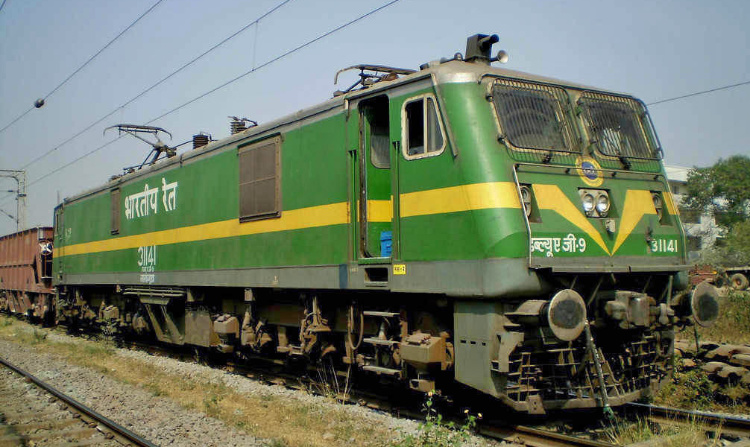
The WAG9's have undergone significant internal design changes since their induction to better suit Indian conditions and loads. The first such change was improving their adhesion characteristics by providing extra ballast (welded in four locations in the machine room). Weight increased from 123t to 132t. These locos are classified as WAG-9H. First one (#31130) was at Gomoh, but was deballasted later because of certain concerns about weight. These concerns were addressed soon with all subsequent locos being made to this heavier specification. The second revision was the provision of IGBT based traction control instead of GTO thyristors starting 2010. These locos were initially classified as WAG-9I, but this designation was short-lived, with locos being simply marked WAG-9H in subsequent production runs.
The third significant change happened in 2016-17, when the brake rigging in these locos was changed. Up until this point, WAG-9/WAG-9Hs had TBUs (Tread Breaking Units) which provided finer control over braking individual axles, especially during wheel slips. But these systems were proving to be unreliable and more expensive to maintain. RDSO decided to replace these TBUs in WAG-9s with more conventional braking systems found in other locomotives. These WAG-9s were designated WAG-9HC. All WAG-9s produced since then are of this type, with many of the older fleet being retrofitted during overhauls.
| Builders | ABB, CLW, DLW, DMW |
| Traction Motors | 6FRA 6068 (850kW, 2180V, 1283/2484 rpm, 270/310A. Weight 2100kg) Axle-hung, nose-suspended |
| Gear Ratio | 77:15, 64:18 |
| Transformer | ABB LOT 6500, 4x1450kVA |
| Traction Control | ABB made UW-2423-2810 with SG 3000G X H24 GTO thyristors, BHEL/Medha SSNA 1200G450300 IGBT with D921S45T diodes |
| Pantographs | Initially Secheron ES10 1Q3-2500, but many later including high-reach ones from Faiveley, Contransys etc. |
| Horsepower | 6125hp |
| Axle Load | WAG-9: 20.5t, WAG-9H/HC: 22.5t |
| Bogies | Co-Co, ABB bogies |
| Weight | WAG-9: 123t, WAG-9H/HC: 132t |
| Starting TE | WAG-9: 46 tons, WAG-9H: 53 tons |
| Max. Speed | 100km/h |
| Length Over Buffers | 20562mm |
These are 9000hp variants of the WAG-9H. As of February 2021, three of them have been produced and are undergoing trials over SECR and SCR. They feature upgraded equipment (traction motors, transformers etc.) from Siemens, BHEL and Medha within the same space envelope and shell design of the WAG-9. Further specifics are unknown at the moment, as is IR's production plan for them.
Initially classified as WAGC-3, these are an experimental class that take WDG-3A diesel locos due for mid-life overhaul and convert them to electric locomotives by utilizing traction motors, bogies and other common components. IR's goal with this type of locomotive was to increase its fleet of electrics at a rapid pace given the vast number of diesel still available. But with less than satisfactory running trials and financial trade-offs, this class is not likely to see further development or production.
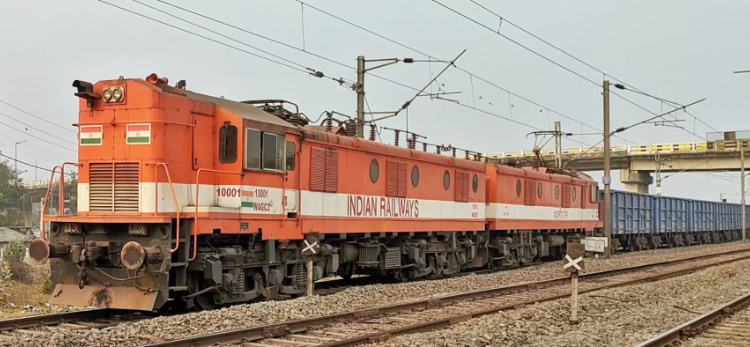
10000hp twin section locos, utilizing two WDG3-A's as the base. Transformers and other electrical equipment replace the ALCo prime mover in the body. Each section gets one pantograph for power collection. Two of these were produced in 2018-19, both homed at Bondamunda shed on SER. #10001 features cab designs from the WDG-3A (with modified controls for an electric loco) with side walls and panels from a WAG-5/WAM-4 locomotive. The second one #10002 has similar side walls and panels, but cabs from the WAG-9.
Another experimental diesel to electric conversion class, this time based on the WDG-4. 12000hp, twin section locos, Co-Co+Co-Co. Traction motors, bogies and other common electrical components from the diesel mated to a WAG-9 shell and cab. GTO based traction control convertors replaced with IGBT based ones. Transformers and other diagnostics/control features come from the WAG-9, with ABB enhancing its software to suit the EMD traction motors better. 2x540 KN maximum tractive effort, with 2x270 KN of regenerative braking effort.
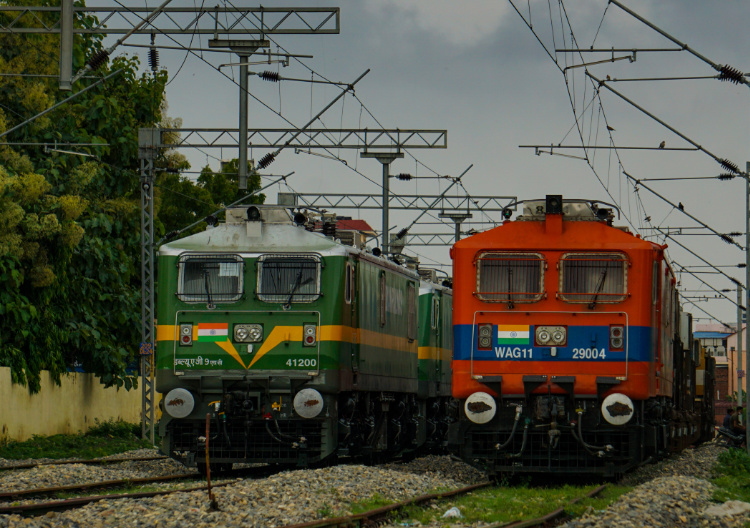
Three of this class have been manufactured by BLW/DLW since 2018. All three have significant differences to each other, despite sharing the same class code. #29001 has the transformer mounted on the body, with changed equipment layouts, a different roof design, an elongated side wall and a modified WDG-4 underframe. #29002 carries much the same design as the previous one, except the transformer is underslung, making the roof design simpler. Equipment layout also is the same as WAG-9. #29003 has cabs on both ends of each section, making each section independently operable in any direction. #29003 also features a modified underframe from a WAP-7 rather than WDG-4. Control, equipment and shell exactly as the WAG-9. This loco also has four pantographs rather than two of the previous units.
Like the WAG-10, this class is not expected to enter serial production. All three units were initialy allocated to the Tughlakabad shed of WCR, but transferred later to Bondamunda on SER where they are seen hauling loads in mineral heavy lines.
Based on Alstom's Prima 2 T8 platform, these are IR's most powerful locomotives in service currently. Twin section, Bo-Bo+Bo-Bo, 12000hp with a maximum tractive effort of 705kN. Axle weight of 22.5t, though a 25t variant is being planned. They can start a 6000 ton train on a 1:150 gradient. Traction motors and transformers from ABB. Each section has one cab with a vestibule connecting both. Two high-reach pantographs, one per section. In a first for freight locomotives on IR, fully blended brakes (regenerative and pneumatic air) are standard equipment. Also as part of standard equipment are a display unit with touch controls to replicate hardware switches. These locos also have crew friendly features like toilets and air-conditioning. They are primarily intended for use on the Eastern DFC, but until that is fully ready, they are being utilised over IR's regular network hauling heavy freight.
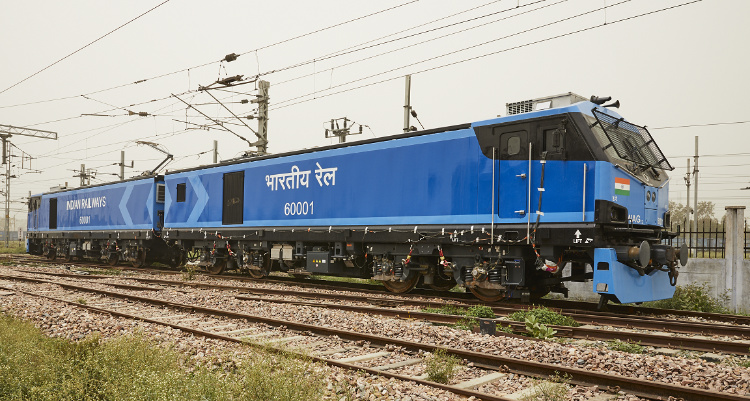
After a global search for suppliers, Alstom won the contract in 2015 with the promise to build 800 locos of this class at a dedicated plant in Madhepura, Bihar. The initial version of this locomotive, classified as WAG-12, had a lot of issues related to ride quality during proving trials. RDSO and Alstom went back to the drawing board and revised a host of things – bogie solebar changed from flat to gooseneck shaped; traction link coupling changed from below the driving cab to middle of the body; distance between bogies increased by nearly 2000mm with a corresponding increase in body length. This variant classified WAG-12B proved successful in trials and is now the only one being produced.
Alstom will provide technical and maintenance for 13 years post production after which IR will assume responsibility. All locos are currently homed at an exclusive shed managed by Alstom at Saharanpur on NR. A second shed at Nagpur is due to be commissioned in October 2022.
| Builders | Alstom |
| Traction Motors | ABB 6FRA 4576D; asynchronous 3-phase induction motors; 3775v, 1508hp at 1750rpm; Nose suspended, force ventilated; 2700kg |
| Transformer | ABB transformer |
| Traction Control | IGBT |
| Pantographs | Two Brecknel Willis high-rise, one for each section |
| Horsepower | 12069hp |
| Axle Load | 22.5t |
| Bogies | Bo-Bo+Bo-Bo |
| Weight | 180t |
| Starting TE | 705 tons |
| Max. Speed | 100km/h |
| Length Over Buffers | 19200mm per unit, 38400mm total |
